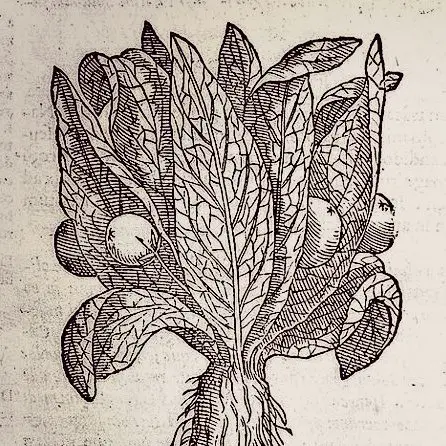A Symbol of love, desire, fertility, numbness, good luck, witchcraft, invulnerability, death.
The mandrake plant grows in the Mediterranean area. Years ago, it was thought only to grow where a man had been hung. It was the product of the semen, blood, and fat from the body. The mandrake was thought to scream as it was pulled from the ground. The mandrake’s roots look like a small human. Mandrake berries are orange or deep yellow and are considered an aphrodisiac.
In Christianity, the mandrake can be found in the first book of the Bible. Rachael was able to conceive Jacob with the help of a mandrake root.

In ancient times in Greece, the mandrake was thought to be an aphrodisiac. Dioscorides, a Greek physician and botanist first wrote about the mandrake in 512 AD. He believed there was a male and female mandrake, but that has since been disproven. Dioscorides also used the word anesthesia for the first time in reference to the mandrake. Used correctly, its roots could help a person go numb and sleep. The mandrake is a symbol of Aphrodite, the Greek goddess of love. The roots were mixed with wine and produced a delightful liquid. The mandrake is called a love apple because of its aphrodisiac qualities.
In Ancient Egypt, the berries were used as an aphrodisiac. The plant is a symbol of desire and love.
In Medieval times, a mandrake root was thought to aid in conception. A woman who wanted to get pregnant would slip a mandrake root shaped like a baby under her pillow. If a man wanted to find love, he would put a mandrake root in the shape of a woman in his pocket. Mandrake roots were also considered lucky charms, so many people carried them for good luck. During this time, practicing witches came up with the idea that anyone trying to dig up a mandrake would hear a shriek and go mad. To avoid this tragedy, people dig until the roots are exposed and then tie a leash to a dog and the root. The dog would pull the mandrake out and suffer the consequences while the human was spared. They did this to discourage commoners from picking the plant. When Christianity took over, they discouraged the use of the mandrake plant. The plant became a symbol of witches and sorcery. Despite this, mandrake lore continued on for over a hundred more years. John Webster and Shakespeare wrote about the plant. Mandrakes also symbolized death throughout the years. While they were used medicinally, they also could be deadly if too much of the plant was used and consumed.
In modern times, the mandrake has found its way into books and films. The plant was featured in Harry Potter. Hand-painted decorative mandrakes are sold around the world. Mandrakes were associated with invulnerability, and badges of large buff mandrakes were made to promote this belief. Mandrake tattoos and jewelry are still found around the world, along with paintings and sculptures.
Symbols Menu:» Amulet
» Ajna
» Arsenic
» Merkaba
» Hung
» Yin Yang
» bindi
» IK Onkar
» Khanda
» Halo
» jiahu
» Tau
» Uraeus
» Menorah
» Quincunx
» Tilaka
» Taijitu
» Vajra
» Chai
» Chi Rho
» Bagua
» Dragon
» Hunab Ku
» Caduceus
» Infinity
» Ichthus
» Hedjet
» Lauburu
» Om
» Ankh
» Chalice
» Pentacle
» Maat
» Ogham
» Mandala
» Kartika
» Khamsa
» Heart
» Labrys
» Sun Face
» Raven
» Triskele
» Scarab
» Dove
» Hanukia
» Anubis
» Trishula
» Durga
» Mezuzah
» Bay Tree
» Geruda
» Kinnara
» Quito
» Condor
» Blue Jay
» Falcon
» Makara
» Rosary
» Uluru
» Apsaras
» Hanuman
» Serpent
» Minotaur
» Mercury
» Apex
» Vestra
» Yoni
» Astarte
» dakini
» Calabash
» Mandrake
» Rebis
» Typhon
» Vegvísir
